In modern office and home environments, height-adjustable desks have become an essential tool for enhancing comfort and work efficiency. Electric, pneumatic, and manual height-adjustable desks are the three main types available on the market, each with its unique features and suitable scenarios. This article will compare these three types of desks from various dimensions to help consumers make better choices.
I. Drive Mechanism and Operational Convenience
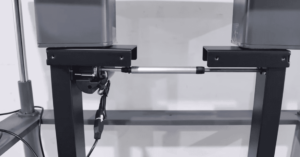 (i) Electric Height-Adjustable Desks
(i) Electric Height-Adjustable Desks
-
Drive Mechanism: The core component of electric height-adjustable desks is the built-in electric motor, which drives the lifting mechanism to achieve smooth desk elevation. Users simply need to press the control buttons on the desk to precisely adjust the height without any physical effort.
-
Operational Convenience: Electric height-adjustable desks are extremely easy to operate, suitable for all users, especially those with limited mobility or less physical strength. In office settings, employees can effortlessly switch between sitting and standing positions, reducing health issues caused by prolonged static postures. Moreover, some high-end models offer memory functions that store frequently used heights, allowing users to adjust to preset levels with a single button press, further enhancing the user experience.
(ii) Pneumatic Height-Adjustable Desks 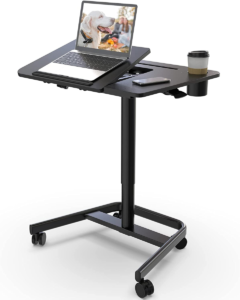
-
Drive Mechanism: Pneumatic height-adjustable desks rely on pneumatic lifting mechanisms, primarily using changes in air pressure to achieve desk elevation. They are equipped with gas springs that adjust the lifting mechanism based on air pressure variations when users apply a certain amount of force.
-
Operational Convenience: Operating pneumatic desks is relatively straightforward but requires users to exert some effort to initiate the lifting process. For users with considerable strength, this operation is quite manageable, but for those with less strength, such as women or the elderly, it may be somewhat challenging. Additionally, users need to continuously apply force to control the lifting speed and height, which is not as convenient as electric desks that offer one-touch adjustments.
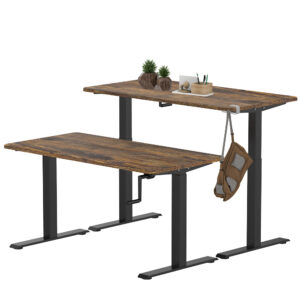 (iii) Manual Height-Adjustable Desks
(iii) Manual Height-Adjustable Desks
-
Drive Mechanism: Manual height-adjustable desks entirely depend on human power to drive the lifting mechanism, with common types including crank-style and lever-style desks. Crank-style desks require users to turn a crank handle, using gear transmission to move the lifting mechanism, while lever-style desks involve pushing a lever up and down, utilizing mechanical structures like connecting rods or slide rails for elevation.
-
Operational Convenience: Operating manual desks is relatively cumbersome, requiring users to invest more physical effort and time. For occasional height adjustments, such as temporarily modifying the desk height to accommodate different work requirements, manual desks can suffice. However, in scenarios requiring frequent adjustments, like prolonged standing work sessions, the inconvenience of manual desks becomes particularly evident, potentially leading to user fatigue and decreased work efficiency.
II. Lifting Stability and Noise Control
(i) Electric Height-Adjustable Desks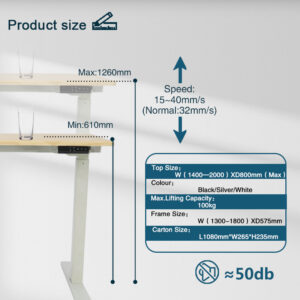
-
Lifting Stability: The lifting process of electric desks is exceptionally stable, thanks to the precise control of the electric motor and stable transmission systems. During elevation, the desk does not exhibit any shaking or jamming, and users hardly notice any instability. This stability is crucial for tasks requiring fine manipulation, such as design drawing or writing, ensuring the integrity and accuracy of work outcomes.
-
Noise Control: Electric desks are designed with noise control in mind, employing advanced motor technology and optimized transmission structures to maintain low noise levels during operation. Some high-quality models operate almost silently, not disturbing the surrounding environment, making them suitable for quiet office or study settings.
(ii) Pneumatic Height-Adjustable Desks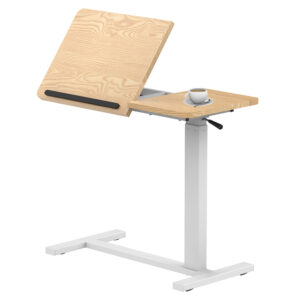
-
Lifting Stability: The lifting process of pneumatic desks is relatively stable, with the gas spring’s cushioning effect reducing shocks and vibrations to some extent. However, due to the characteristics of pneumatic systems, slight wobbling may occur during rapid lifting, especially noticeable in fast adjustments. For tasks with extremely high stability requirements, pneumatic desks may not fully meet the needs.
-
Noise Control: Pneumatic desks generate some noise during operation, primarily from the flow and friction of air within the gas springs. Although the noise is not extremely loud, it can still be perceived in quiet environments. For office or study spaces that require silence, the noise from pneumatic desks may cause some interference.
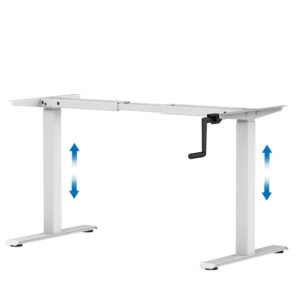 (iii) Manual Height-Adjustable Desks
(iii) Manual Height-Adjustable Desks
-
Lifting Stability: The lifting stability of manual desks is relatively poor, as it entirely depends on human operation. Inconsistencies in force application or unstable operation when turning the crank handle or pushing the lever can cause the desk to shake or jam during elevation. Moreover, mechanical structures in manual desks may wear or loosen over time, further affecting lifting stability.
-
Noise Control: Manual desks produce noise during operation, mainly from the friction and collision between mechanical components. Crank-style desks emit sounds when the crank handle meshes with gears, and lever-style desks generate noise from the movement of levers, slide rails, connecting rods, and other parts. While the noise level varies depending on the brand and quality, manual desks generally have less effective noise control compared to electric and pneumatic desks.
III. Price and Cost-Effectiveness
 (i) Electric Height-Adjustable Desks
(i) Electric Height-Adjustable Desks
-
Price: Electric desks typically have a higher price point due to the integration of electric motors, control systems, and other complex electronic components, which increase production costs. Additionally, high-end models with intelligent controls and memory functions are even more expensive. The price range for electric desks is quite broad, spanning from thousands to tens of thousands of dollars, depending on factors like brand, features, and quality.
-
Cost-Effectiveness: Despite the higher price, electric desks offer excellent cost-effectiveness in scenarios requiring frequent adjustments. Their convenience, stability, and noise control make them ideal for users seeking efficient work and a comfortable experience. Over the long term, the ease and stability of electric desks reduce the time and effort needed for frequent height adjustments, effectively lowering usage costs.
(ii) Pneumatic Height-Adjustable Desks
-
Price: Pneumatic desks are relatively affordable, cheaper than electric desks but more expensive than manual ones. Their production costs are lower since they consist of simpler structures, primarily gas springs and lifting mechanisms, without the need for complex electronic components.
-
Cost-Effectiveness: Pneumatic desks strike a balance between price and performance. They are an economical choice for users with budget constraints who still require some lifting functionality. In scenarios where frequent adjustments are not necessary or where stability and noise control requirements are not extremely high, pneumatic desks meet basic needs with good cost-effectiveness. However, for users needing frequent adjustments or with higher demands for stability and noise control, the cost-effectiveness of pneumatic desks is relatively lower.
(iii) Manual Height-Adjustable Desks
-
Price: Manual desks are the most cost-effective option, with the lowest prices among the three types. Their production costs are minimal, as they are made up of simple mechanical components and have straightforward manufacturing processes. Manual desks on the market typically range from a few hundred to a thousand dollars, making them an ideal choice for users with limited budgets.
-
Cost-Effectiveness: The cost-effectiveness of manual desks is primarily reflected in their low prices. For users who only occasionally need adjustments or have low requirements for lifting functionality, manual desks meet basic needs at an affordable cost. However, in scenarios requiring frequent adjustments or with higher demands for operational convenience and stability, the cost-effectiveness of manual desks is lower, as users must invest more physical effort and time in the adjustment process, leading to a poorer user experience.
IV. Applicable Scenarios and User Groups
 (i) Electric Height-Adjustable Desks
(i) Electric Height-Adjustable Desks
-
Applicable Scenarios: Electric desks are highly suitable for modern office environments, especially in settings that require frequent switching between sitting and standing positions. For instance, in open-plan offices, creative studios, and programmer workspaces, employees can adjust desk heights at any time to achieve seamless transitions between standing and seated work. Additionally, electric desks are ideal for home environments like studies and learning spaces, providing comfortable experiences for family members.
-
User Groups: The user base for electric desks is quite broad, including office workers, students, designers, programmers, and others. For users pursuing efficient work and a healthy lifestyle, electric desks are an excellent choice. Moreover, for individuals with limited mobility or less physical strength, such as the elderly or pregnant women, electric desks offer immense convenience in easily adjusting desk heights.
(ii) Pneumatic Height-Adjustable Desks
-
Applicable Scenarios: Pneumatic desks are suitable for scenarios where cost is a concern but some lifting functionality is still needed. For example, in small offices of startup companies, home studios, and temporary work areas, users can employ pneumatic desks to meet basic lifting requirements while controlling costs. Additionally, pneumatic desks are appropriate for situations where the frequency of adjustments is not particularly high, such as when occasionally changing desk heights to accommodate different work tasks.
-
User Groups: The user base for pneumatic desks includes small business owners, freelancers, and family users. For users with budget constraints who still wish to enhance the comfort of their office or study environments, pneumatic desks are a good option. Moreover, for users with considerable strength, such as men, operating pneumatic desks may feel more comfortable and effortless.
 (iii) Manual Height-Adjustable Desks
(iii) Manual Height-Adjustable Desks
-
Applicable Scenarios: Manual height-adjustable desks are suitable for scenarios where occasional adjustments are needed or where the demand for lifting functionality is not high. For instance, in budget-constrained office environments, such as small startups or school classrooms, manual desks can meet basic usage requirements while saving costs. Additionally, in home settings, like children’s study desks or spaces that do not require frequent height adjustments, manual desks are an economical choice.
-
User Groups: The user base for manual desks includes small businesses with limited budgets, schools, and family users. For users who have low requirements for lifting functionality or do not mind exerting some physical effort, such as students and housewives, manual desks can fulfill their basic needs. Moreover, for individuals who enjoy DIY or are interested in mechanical operations, manual desks also hold a certain appeal, as they can manually adjust the desk height and enjoy the process of operation.
V. Safety and Durability
 (i) Electric Height-Adjustable Desks
(i) Electric Height-Adjustable Desks
-
Safety: Electric desks have certain advantages in terms of safety. Some high-end models are equipped with anti-pinch features that automatically stop or reverse the lifting process when resistance is encountered, preventing users’ fingers from getting pinched. Additionally, the electrical design of electric desks takes safety into account, incorporating features like overload protection and short-circuit protection to ensure user safety during use.
-
Durability: The durability of electric desks mainly depends on the quality of their internal electric motors and transmission systems. High-quality electric desks use superior motors and durable transmission components, capable of withstanding prolonged frequent use and offering a longer service life. However, the electronic components in electric desks may experience malfunctions over time, requiring regular maintenance and inspection to ensure their proper functioning.
(ii) Pneumatic Height-Adjustable Desks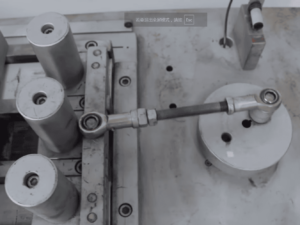
-
Safety: The safety of pneumatic desks is relatively lower. Users need to apply a certain amount of force during operation, and improper handling may lead to damage or instability of the pneumatic mechanism, causing accidents. Moreover, issues like gas spring leakage may arise during the lifting process, necessitating careful operation and regular inspection of the pneumatic system’s sealing.
-
Durability: The durability of pneumatic desks primarily depends on the quality of the gas springs and the stability of the lifting mechanism. High-quality gas springs and robust lifting mechanisms can ensure the stability and durability of pneumatic desks over long-term use. However, the pneumatic system may wear or age over time, requiring periodic replacement of gas springs and other components to maintain normal functionality.
(iii)
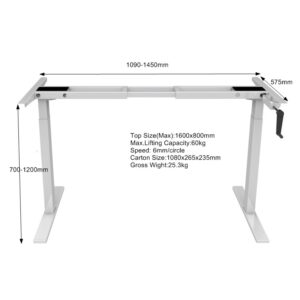
575mm
700-1200mm
Top Size(Max):1600x800mmMax.Lifting Capacity:60kgSpeed:6mm/circleCarton Size:1080x265x235mmGross Wight:25.3kg
Manual Height-Adjustable Desks
-
Safety: The safety of manual desks mainly depends on the design and quality of their mechanical structures. Some manual desks may experience issues like loose or detached mechanical components during operation, requiring careful handling and regular inspection of the connections between mechanical parts. Additionally, users need to apply force during the lifting process, and improper operation may result in strains or pulls.
-
Durability: Manual desks generally have higher durability, as their mechanical components can withstand long-term use under normal conditions. However, mechanical structures in manual desks will also experience wear and damage over time, necessitating regular maintenance and care to maintain their good working condition. Some low-quality manual desks may encounter failures due to substandard mechanical components, affecting their service life.
VI. Conclusion and Recommendations
In summary, electric, pneumatic, and manual height-adjustable desks each have their unique features and suitable scenarios. Electric desks excel in operational convenience, lifting stability, and noise control, making them ideal for users who need frequent adjustments and pursue efficient work and a comfortable experience. Pneumatic desks strike a balance between price and performance, suitable for users with budget constraints who still require some lifting functionality. Manual desks, with their low prices, are the best choice for users with limited budgets and low demands for lifting functionality.
When choosing a height-adjustable desk, users should consider their actual needs, budget, and usage scenarios. If the budget is ample and there are high demands for user experience, electric desks are undoubtedly the best choice. If the budget is limited but some lifting functionality is needed, pneumatic desks can meet basic requirements. For users with very tight budgets and low demands for lifting functionality, manual desks offer an economical option. Additionally, users should also consider factors such as the desk’s safety, durability, brand, and after-sales service to ensure they purchase a product with high cost-effectiveness that meets their needs.


